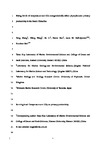Rising levels of temperature and CO2 antagonistically affect phytoplankton primary productivity in the South China Sea.
| dc.contributor.author | Zhang, Y | |
| dc.contributor.author | Wang, T | |
| dc.contributor.author | Li, H | |
| dc.contributor.author | Bao, N | |
| dc.contributor.author | Hall-Spencer, Jason | |
| dc.contributor.author | Gao, K | |
| dc.date.accessioned | 2018-10-18T12:36:39Z | |
| dc.date.issued | 2018-10 | |
| dc.identifier.issn | 0141-1136 | |
| dc.identifier.issn | 1879-0291 | |
| dc.identifier.uri | http://hdl.handle.net/10026.1/12579 | |
| dc.description.abstract |
Coastal and offshore waters in the South China Sea are warming and becoming acidified due to rising atmospheric levels of carbon dioxide (CO2), yet the combined effects of these two stressors are poorly known. Here, we carried out shipboard incubations at ambient (398 μatm) and elevated (934 μatm) pCO2 at in situ and in situ+1.8 °C temperatures and we measured primary productivity at two coastal and two offshore stations. Both warming and increased CO2 levels individually increased phytoplankton productivity at all stations, but the combination of high temperature and high CO2 did not, reflecting an antagonistic effect. Warming decreased Chl a concentrations in off-shore waters at ambient CO2, but had no effect in the coastal waters. The high CO2 treatment increased night time respiration in the coastal waters at ambient temperatures. Our findings show that phytoplankton assemblage responses to rising temperature and CO2 levels differ between coastal and offshore waters. While it is difficult to predict how ongoing warming and acidification will influence primary productivity in the South China Sea, our data imply that predicted increases in temperature and pCO2 will not boost surface phytoplankton primary productivity. | |
| dc.format.extent | 159-166 | |
| dc.format.medium | Print-Electronic | |
| dc.language | en | |
| dc.language.iso | en | |
| dc.publisher | Elsevier | |
| dc.subject | Chl a | |
| dc.subject | Night time respiration | |
| dc.subject | Ocean acidification | |
| dc.subject | Ocean warming | |
| dc.subject | Primary productivity | |
| dc.subject | South China Sea | |
| dc.title | Rising levels of temperature and CO2 antagonistically affect phytoplankton primary productivity in the South China Sea. | |
| dc.type | journal-article | |
| dc.type | Journal Article | |
| plymouth.author-url | https://www.ncbi.nlm.nih.gov/pubmed/30180993 | |
| plymouth.volume | 141 | |
| plymouth.publication-status | Published | |
| plymouth.journal | Marine Environmental Research | |
| dc.identifier.doi | 10.1016/j.marenvres.2018.08.011 | |
| plymouth.organisational-group | /Plymouth | |
| plymouth.organisational-group | /Plymouth/Faculty of Science and Engineering | |
| plymouth.organisational-group | /Plymouth/Faculty of Science and Engineering/School of Biological and Marine Sciences | |
| plymouth.organisational-group | /Plymouth/PRIMaRE Publications | |
| plymouth.organisational-group | /Plymouth/REF 2021 Researchers by UoA | |
| plymouth.organisational-group | /Plymouth/REF 2021 Researchers by UoA/UoA07 Earth Systems and Environmental Sciences | |
| plymouth.organisational-group | /Plymouth/Research Groups | |
| plymouth.organisational-group | /Plymouth/Research Groups/Marine Institute | |
| plymouth.organisational-group | /Plymouth/Users by role | |
| plymouth.organisational-group | /Plymouth/Users by role/Academics | |
| dc.publisher.place | England | |
| dcterms.dateAccepted | 2018-08-23 | |
| dc.rights.embargodate | 2019-8-29 | |
| dc.identifier.eissn | 1879-0291 | |
| dc.rights.embargoperiod | Not known | |
| rioxxterms.versionofrecord | 10.1016/j.marenvres.2018.08.011 | |
| rioxxterms.licenseref.uri | http://www.rioxx.net/licenses/all-rights-reserved | |
| rioxxterms.licenseref.startdate | 2018-10 | |
| rioxxterms.type | Journal Article/Review |


